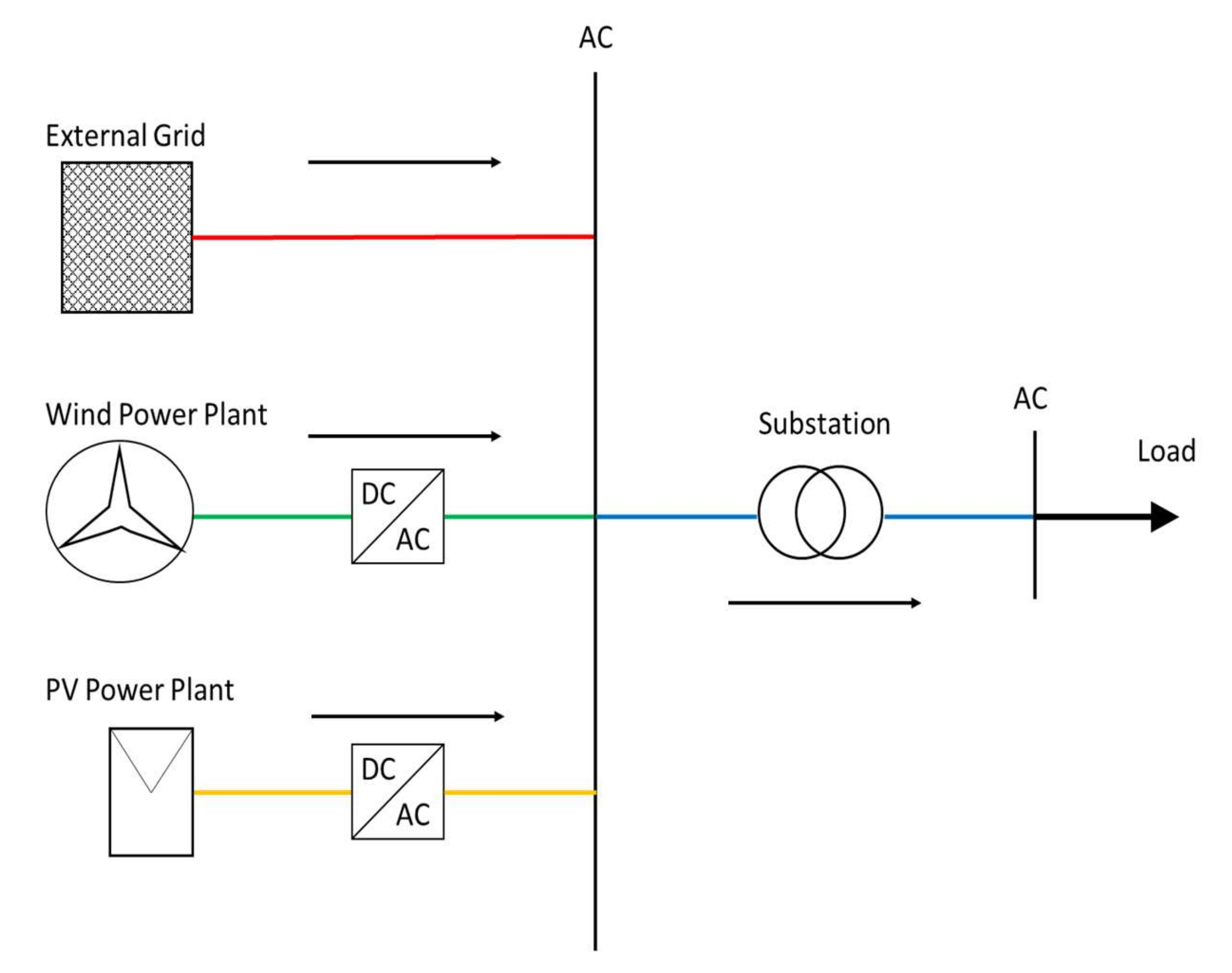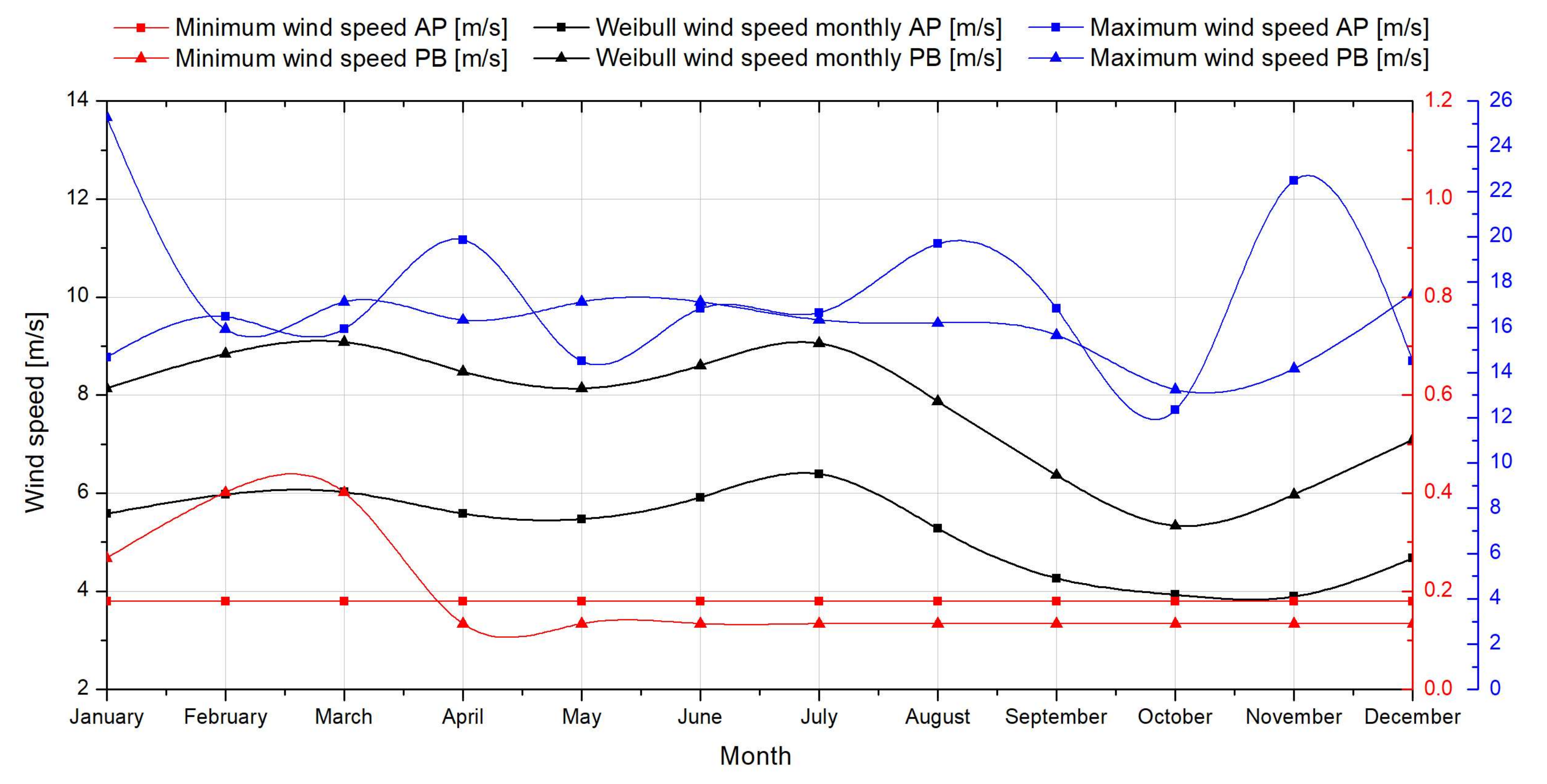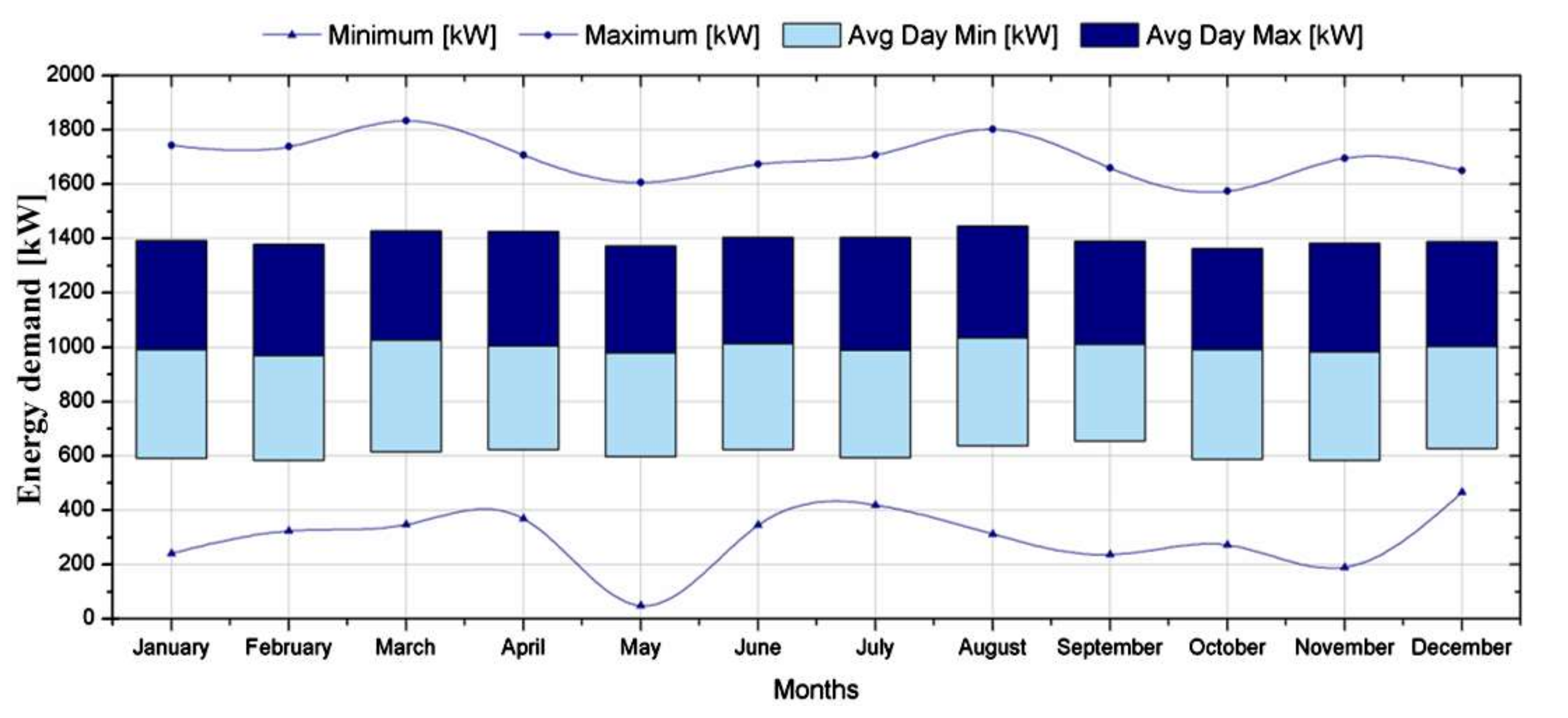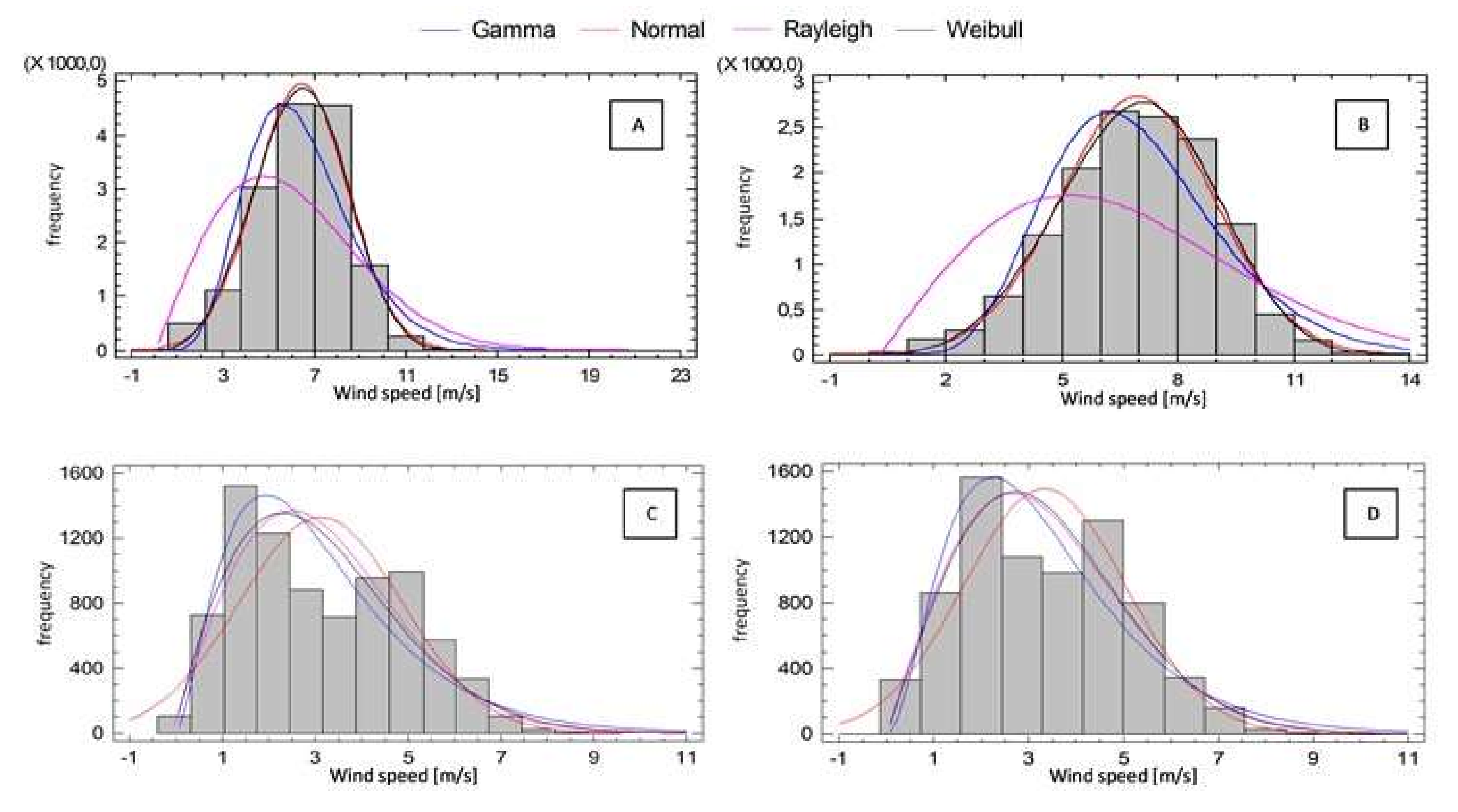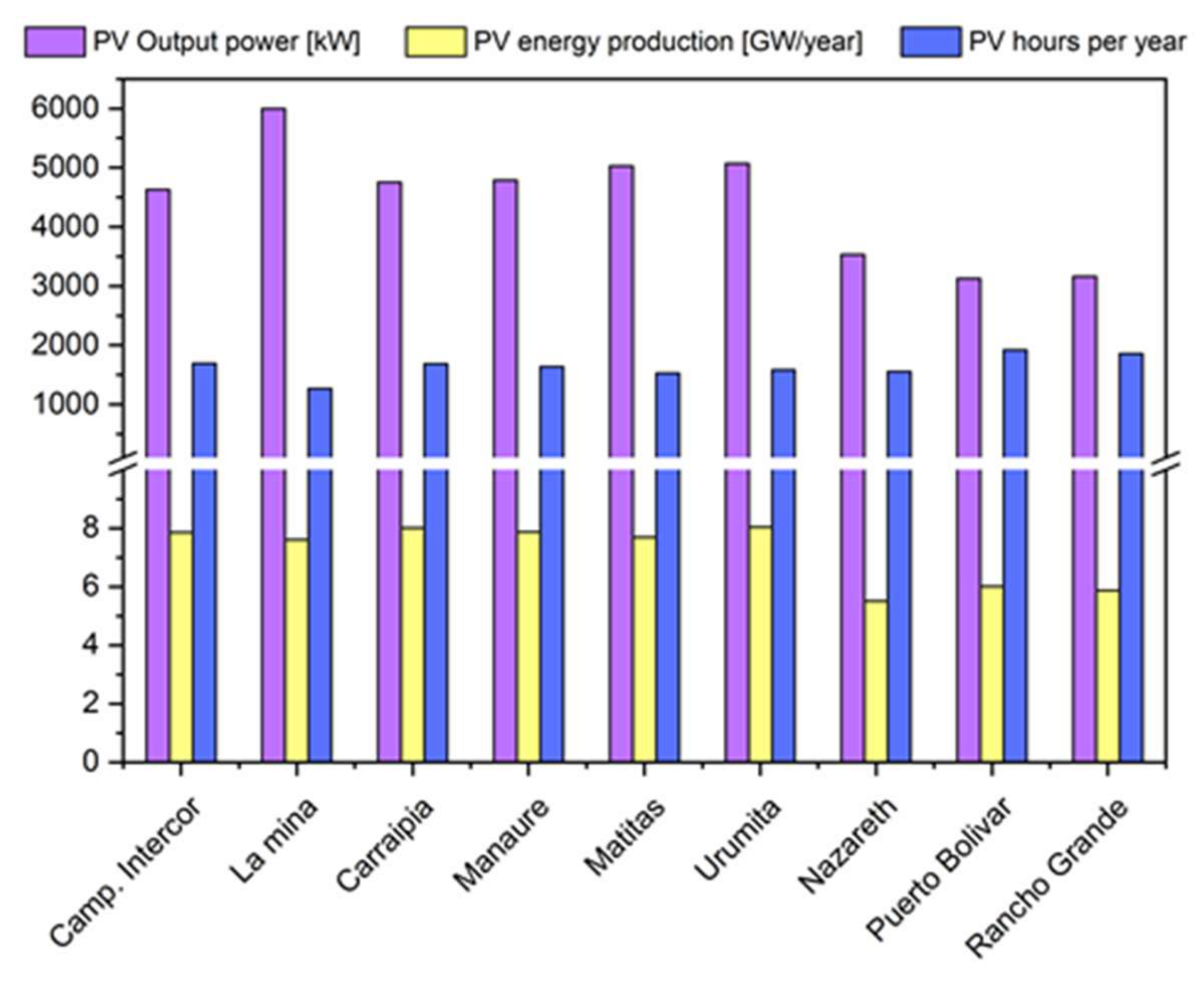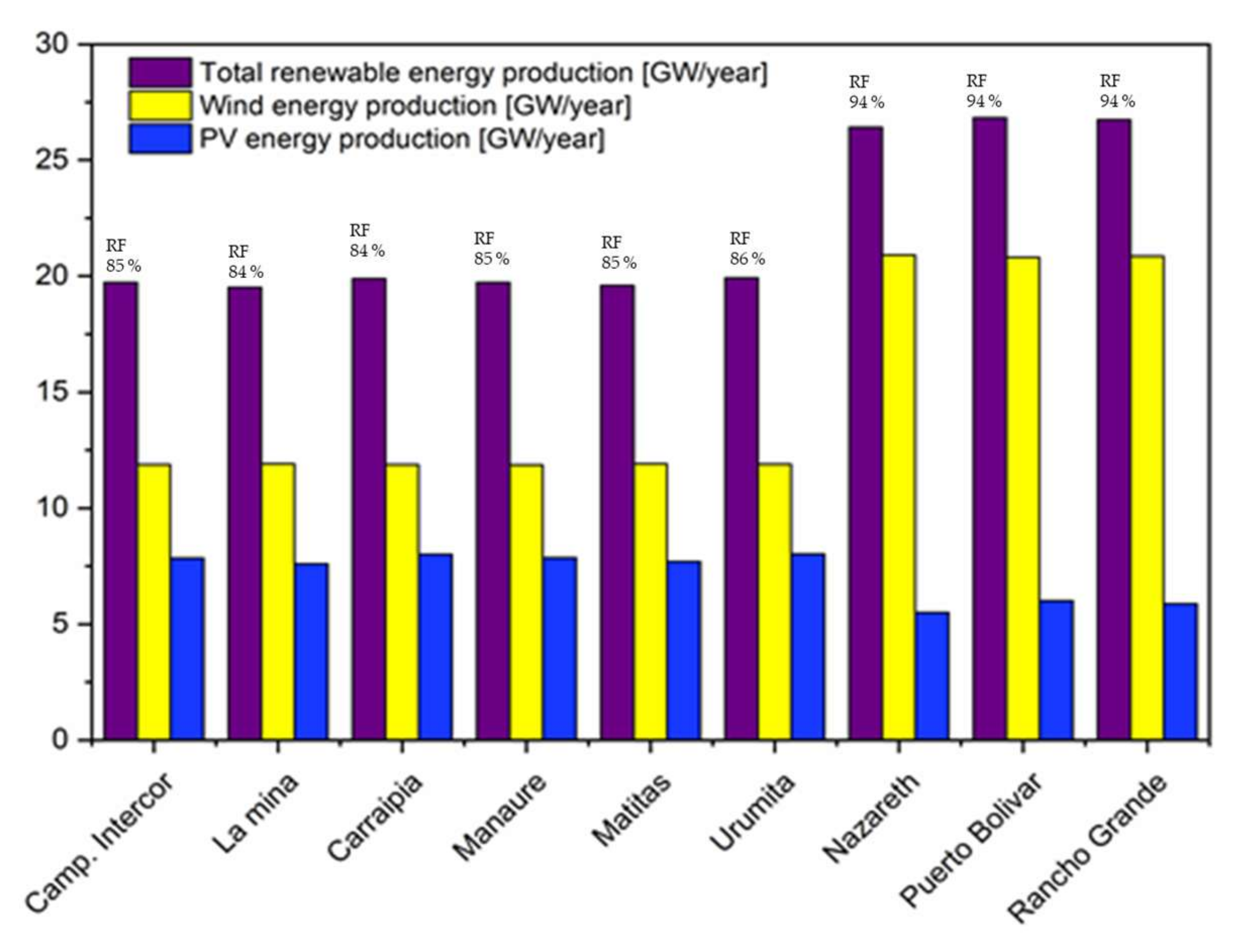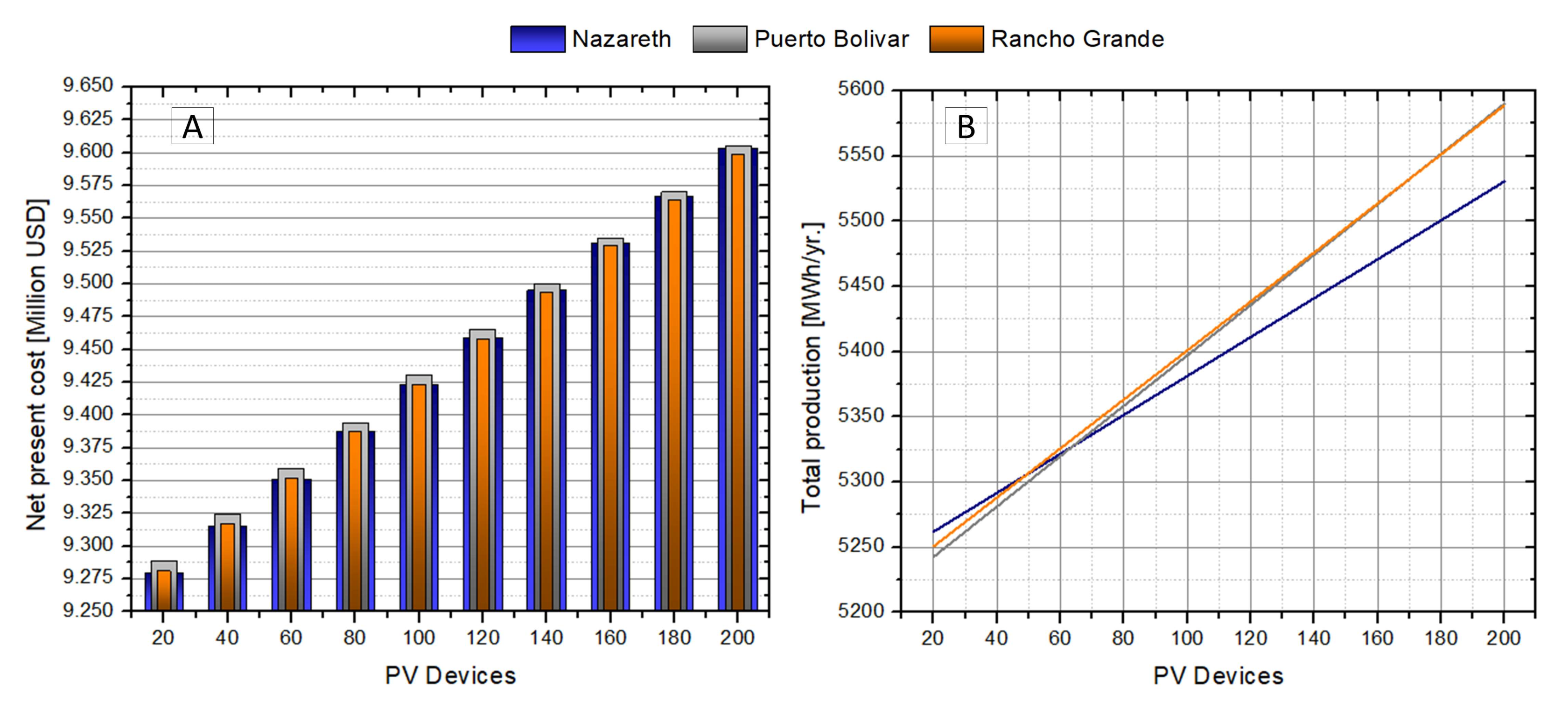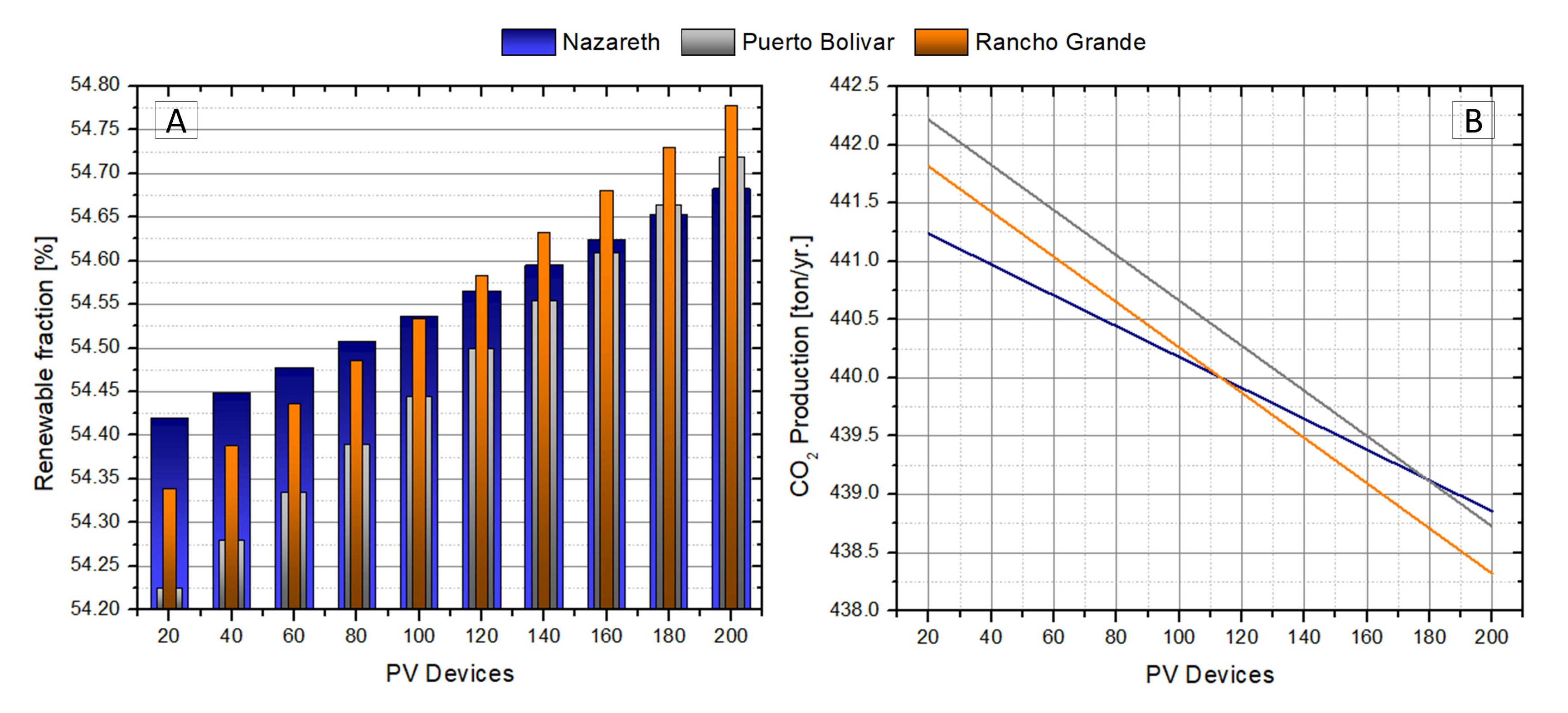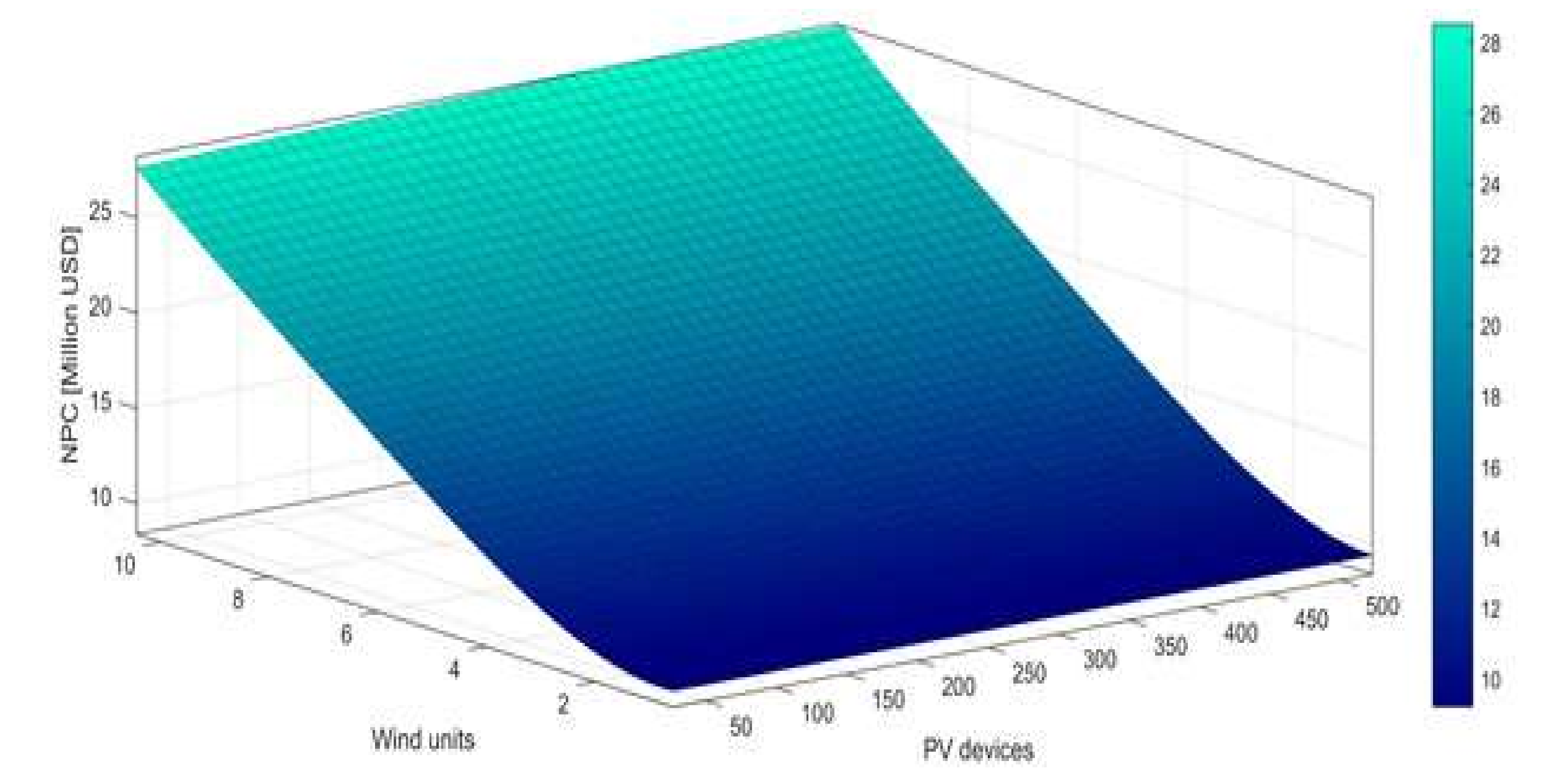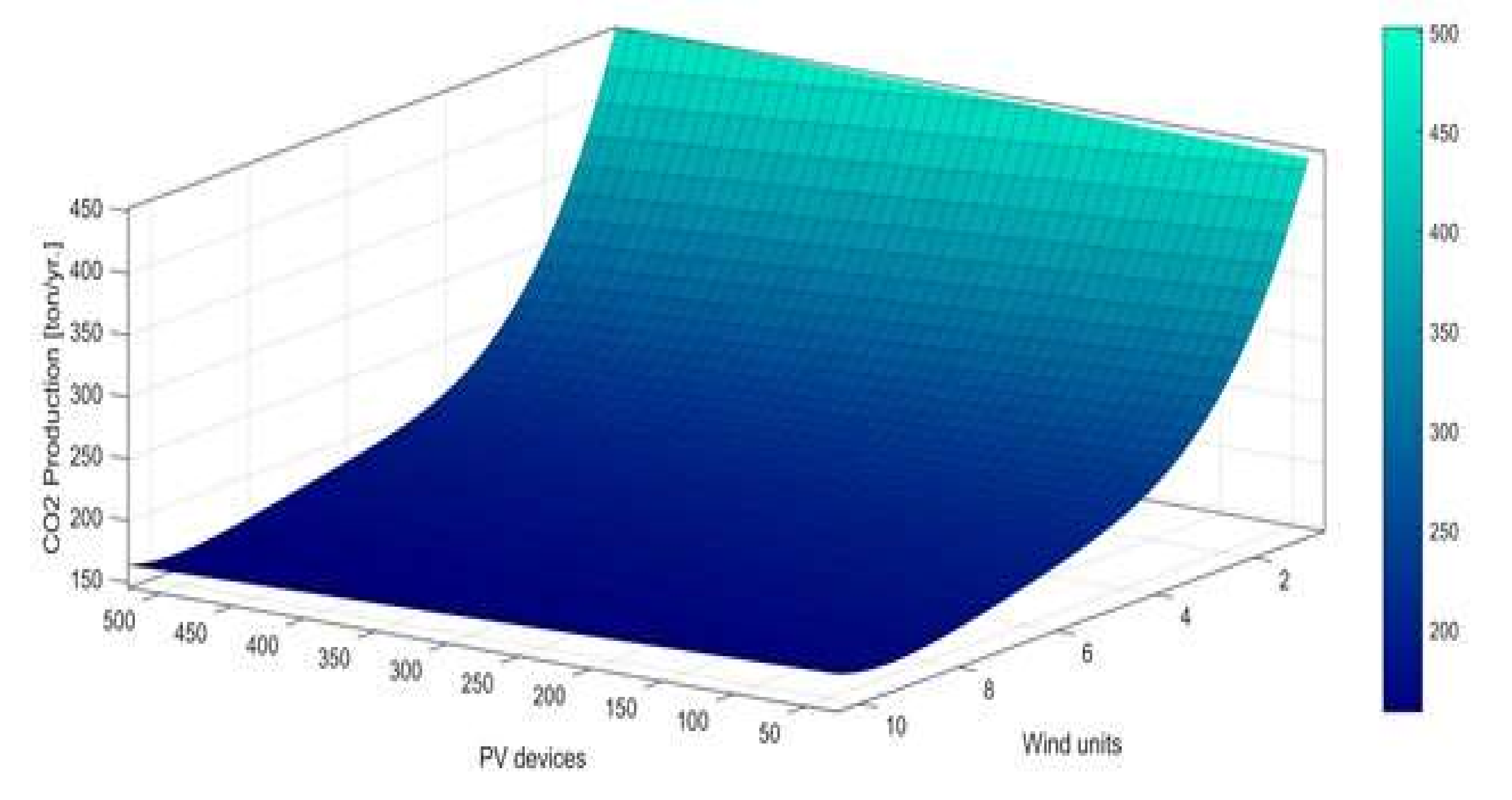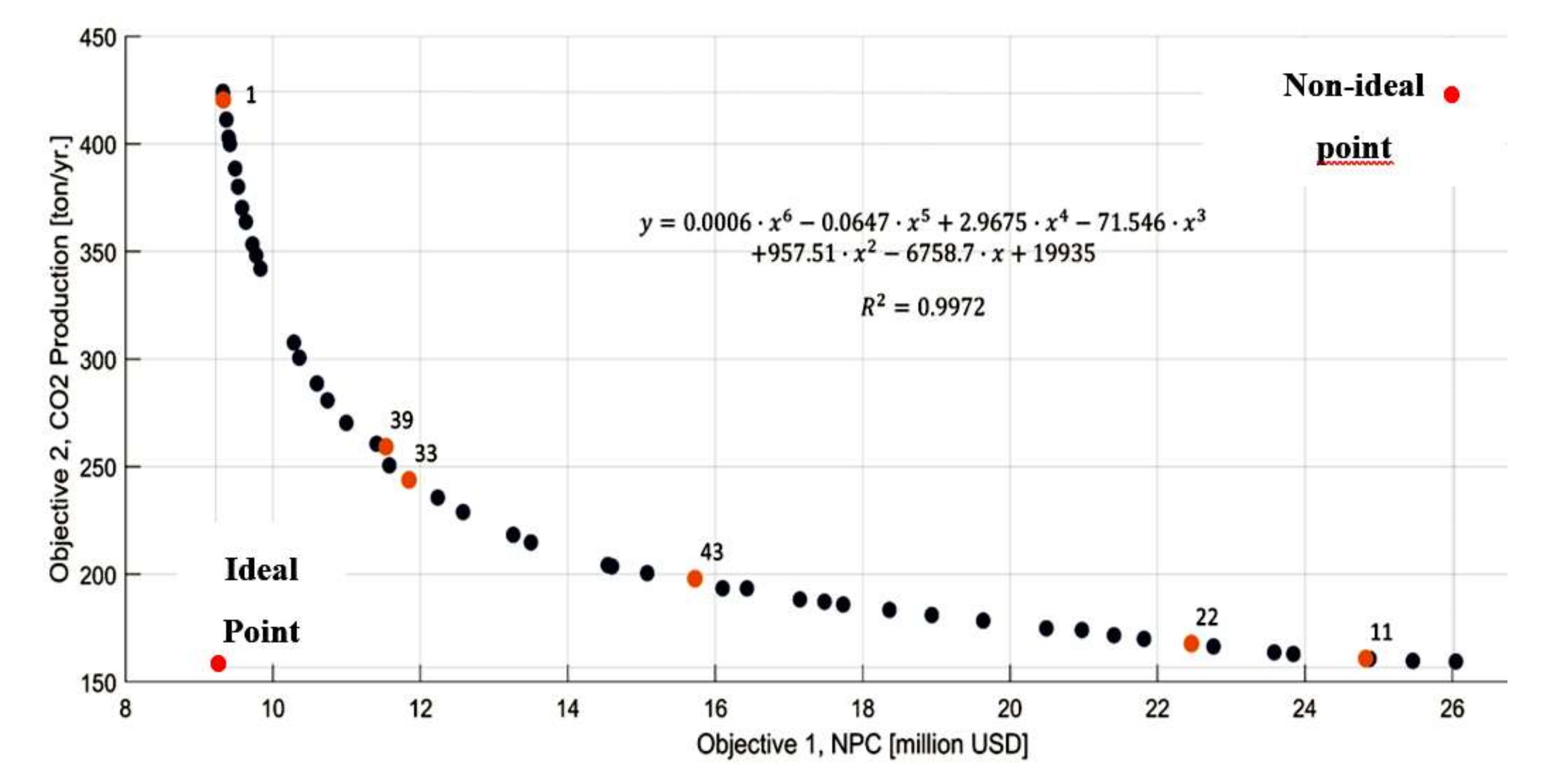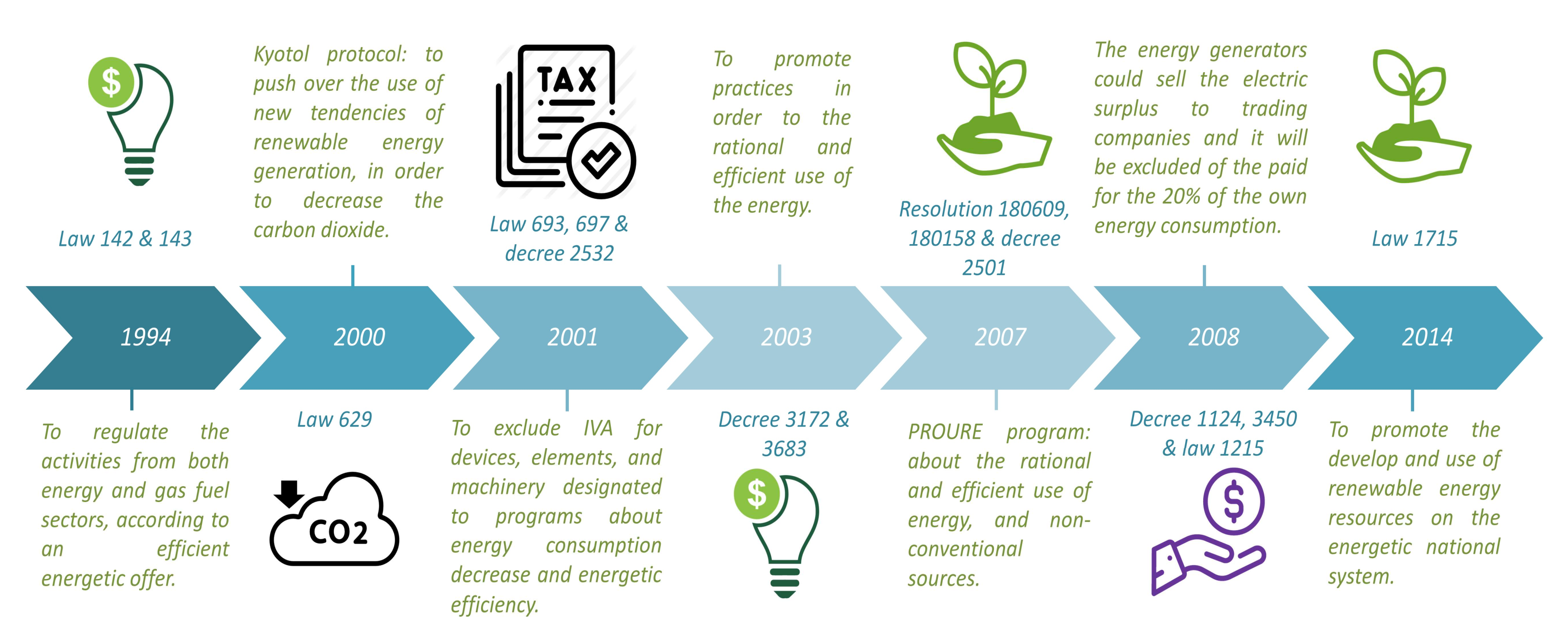This section presents the energy results, economic perspective, and multi-objective optimization.
4.1. Energy Results
Figure 7 shows the profile of the energy production obtained by PV systems, their nominal output power, and equivalent PV hours per year in multiple locations in La Guajira, Colombia. In this step, device replacement and capital costs are not considered, because the objective of this section is to evaluate the energy generation potential of the hybrid system.
Figure 7 shows that the most significant annual energy production is in the town of Urumita. However, this does not mean that Urumita is the best location. It is necessary to quantify the efficiency of the devices to determine an optimal location for the PV system. The fraction between the nominal PV power and the energy generated per year gives a specific number of hours for each location in one year. Therefore, it estimates how PV arrays take advantage of solar light during operation, which means that locations where PV arrays have the longer number of hours per year will take more advantage of solar radiation.
On the other hand, it is necessary to highlight that PV output power indicates the nominal power for all the set of PV arrays connected between them, which are made of 4 panels with 250 W each. On this basis, Puerto Bolívar was identified as the location where the system works with the highest number of hours, despite having less energy generation compared to the other locations. This means that Puerto Bolívar is the best place to use our PV system. In percentage terms, the efficiency of this system is the fraction between the worked hours per year and the hours of one year, which gives an efficiency of 21.9%.
Subsequently, the optimal location for the wind system was determined. Considering that the use of wind turbines with hub height of 80 m and nominal power of 1.5 MW is fixed, a comparison was made between the number of wind turbines (given by the software for each location) and the energy production generated per year, which points towards the ideal location (
Figure 8).
Figure 8 shows six locations where the system considered five 1.5 MW turbines to reach the energy production plotted in the previous graphic for each location, while the other three only needed four turbines to reach a higher amount of energy. Thus, these three locations were analysed to find the area with the highest generation of wind power: Nazareth was identified as the location with 0.4% and 0.18% more wind power, compared to Puerto Bolívar and Rancho Grande, respectively.
After the best location for installation of the wind generation system was identified, the optimal general location was determined since the optimal sites for both types of devices are different. Therefore, it was necessary to analyse the percentage of renewable fraction present in each of the locations to identify which of these two locations generates the highest amount of renewable energy. The renewable fraction in a system is the ratio of the amount of clean energy produced and the total energy demand of our system.
Once the optimal location was determined, the parameters of the hybrid renewable energy generation plant were modified to increase power generation, resulting in a decrease in costs.
Figure 9 shows that Nazareth, Puerto Bolivar, and Rancho Grande are the locations with the highest RF percentage to produce energy by renewable resources. However, these values have a minimal difference, which means that it is necessary to verify the second step of the simulation; this refers to an economic perspective to determine the optimal location.
4.2. Economic Perspective
The simulation requires capital and replacement costs for PV systems and wind turbines. A generic PV array (1 kW; 4 × 250 W) with a capital cost of USD 3000 and a replacement cost of USD 3000 was used. Generic wind turbines of 1.5 MW with a capital cost of USD 3,000,000 and a replacement cost of USD 3,000,000 were used. The effects of temperature were considered in the simulation.
Using generic energy demand based on the requirements of La Guajira department, simulation at this stage resulted in a single generic wind turbine for each location. Therefore,
Figure 10 and
Figure 11 show the relationship of the number of PV panels with net present cost (NPC), total energy production, a fraction of renewable energy, and CO
2 emissions for the following locations: Nazareth, Port Bolívar, and Rancho Grande.
Figure 10A shows that Nazareth and Rancho Grande are the locations where the NPC of the entire project, based on the number of PV panels implemented, is the lowest. Practically, the NPC for Nazareth and Rancho Grande are the same, which means that it is necessary to consider the following criteria to make the right decision about which place is optimal. In the town of Nazareth, the reason for total energy production and the number of PV panels is the lowest, compared to the localities of Rancho Grande and Puerto Bolívar. In addition,
Figure 10B shows that the total energy production in Rancho Grande remains the best for at least 200 PV arrays. Another essential criterion considered was the renewable fraction. It is critical to highlight that a 1 PV device or 1 PV unit is equal to a 1 PV array for this simulation analysis.
Figure 11A shows that Nazareth and Rancho Grande have almost the same fraction values to produce energy by renewable energy, which are higher than those of Puerto Bolívar. This means that Puerto Bolívar is not the optimal place to implement a hybrid PV and wind power plant. Even if the location has good production values, its renewable fraction is the lowest, resulting in a high NPC.
The last criterion to study is the CO
2 emission produced by thermoelectric power plants and the acquisition of other non-renewable energy sources.
Figure 11B shows that CO
2 emissions in Nazareth are lower than those of Rancho Grande when there are 110 PV arrays. For large numbers of PV units, lower CO
2 production is located in Rancho Grande, making it the best possible location.
4.3. Multi-Objective Optimization of Rancho Grande for Location of a Hybrid System
Considering that Rancho Grande was identified as the optimal location to implement a hybrid wind and PV system, the next stage sought to determine, through the optimization of multiple objectives, the most efficient combination of the number of PV devices and wind turbines.
Wind turbines in the range of 1 to 10 and the number of PV arrays in the range of 50 to 500 were implemented. A matrix was then developed for current NPC and CO2 production based on PV devices and wind turbines.
A mathematical function for each criterion, NPC (Equation (11)) and CO
2 (Equation (12)), was determined using the MATLAB curve fitting tool.
Figure 12 and
Figure 13 show the corresponding polynomial regressions with their respective functions.
These functions were useful in developing a MATLAB code for a multi-objective optimization process.
Figure 12 shows the behavior of the NPC as a function of the PV devices and the wind units. It was necessary to use fourth-degree polynomial regression to obtain the minimum percentage of error, 0.0001%. Equation (11) is the mathematical function of the net present cost (NPC), where “x” is the number of PV units and “y” is the number of wind turbines.
Figure 13 shows the behaviour of CO
2 production as a function of the number of wind units and PV devices. Equation (12) is the corresponding mathematical function for CO
2 emissions, where “x” is the number of PV units, and “y” is the number of wind turbines. As can be seen, the effect of PV devices on CO
2 production is negligible, compared to the wind unit.
The optimization was conducted considering Objective 1 (the current NPC), and Objective 2 (the production of CO
2) with the two functions mentioned above. The purpose was to minimize both criteria using Pareto’s efficiency. For each data of PV arrays and wind turbines, there are values of current NPC and CO
2 Production, as given in
Table 5 (only a range of values was placed, since it can be more extensive).
f
1(x,y) and f
2(x,y) from
Table 5, which are the values for NPC and CO
2 production, respectively, were then plotted (
Figure 14).
It is important to note that
Table 5 shows values that are not feasible due to decimal values; for example, index 17 gives 8.58 wind turbines. Decimal values are out of range because it is impossible to install 8.58 wind turbines of 1.5 MW. When choosing the nearest integer values, a considerable error was generated. On the other hand, PV arrays do not have this problem because their units are high, making it possible to approximate decimals to the nearest integer.
For this reason, it was necessary to determine the index that has the nearest integer for wind turbine devices, with at least 0.01 difference of any integer, as shown in
Table 6.
While it is necessary to choose one of these values, it is important to note that all the previous data were optimal combinations, that is, data that is the best possible option for a specific number of selected devices.
Figure 14 shows the locations of these indexes (in orange dots).
Figure 14 is a Pareto front composed of values of f
1(x,y) and f
2(x,y) shown in
Table 5, which represents the net present cost (NPC) and CO
2 emissions, respectively. In addition, the characteristic equation is presented, where “x” is the number of PV arrays, and “y” is the number of wind turbines. Orange dots are the possible values given in
Table 6, which represent specific configurations for the purposed hybrid plant. The ideal point is described as the interception of the vertical axis in the lowest value of CO
2 production with the horizontal axis in the lowest value of the Net Present Cost. The non-ideal point is described as the interception of the horizontal axis generated from the higher amount of CO
2 production with the vertical axis generated from the higher value of the Net Present Cost. Both ideal points are represented with red dots.
The next step is to implement the Technique for Order of Preference by Similarity to Ideal Solution (TOPSIS) method, which states that the selected point (taken in
Figure 14) should have the shortest geometric length from the positive ideal solution and the most extended geometric length from the perfect negative solution. This optimization method has been widely used to improve the thermal and economic performance of energy systems [
31,
32,
33]. Indexes 39 and 33 are the closest to the desired condition, as shown in
Table 7.
Equation (10) is used to choose between the two values. The index with the value of Sy closest to 1 is the right point. The index 33 is closer to 1, making it the best possible option; therefore, a total of 441 PV arrays (1764 modules of 250 W) and 3 wind turbines of 1.5 MW should be used, resulting in an estimated NPC cost of 11.8 million dollars, and estimated CO2 emission of 244.1 tons per year.
In this way, the best parameters that offer minimum energy costs to the residents, minimum emissions of pollutant gases, and maintain a reasonable energy production rate are obtained.

